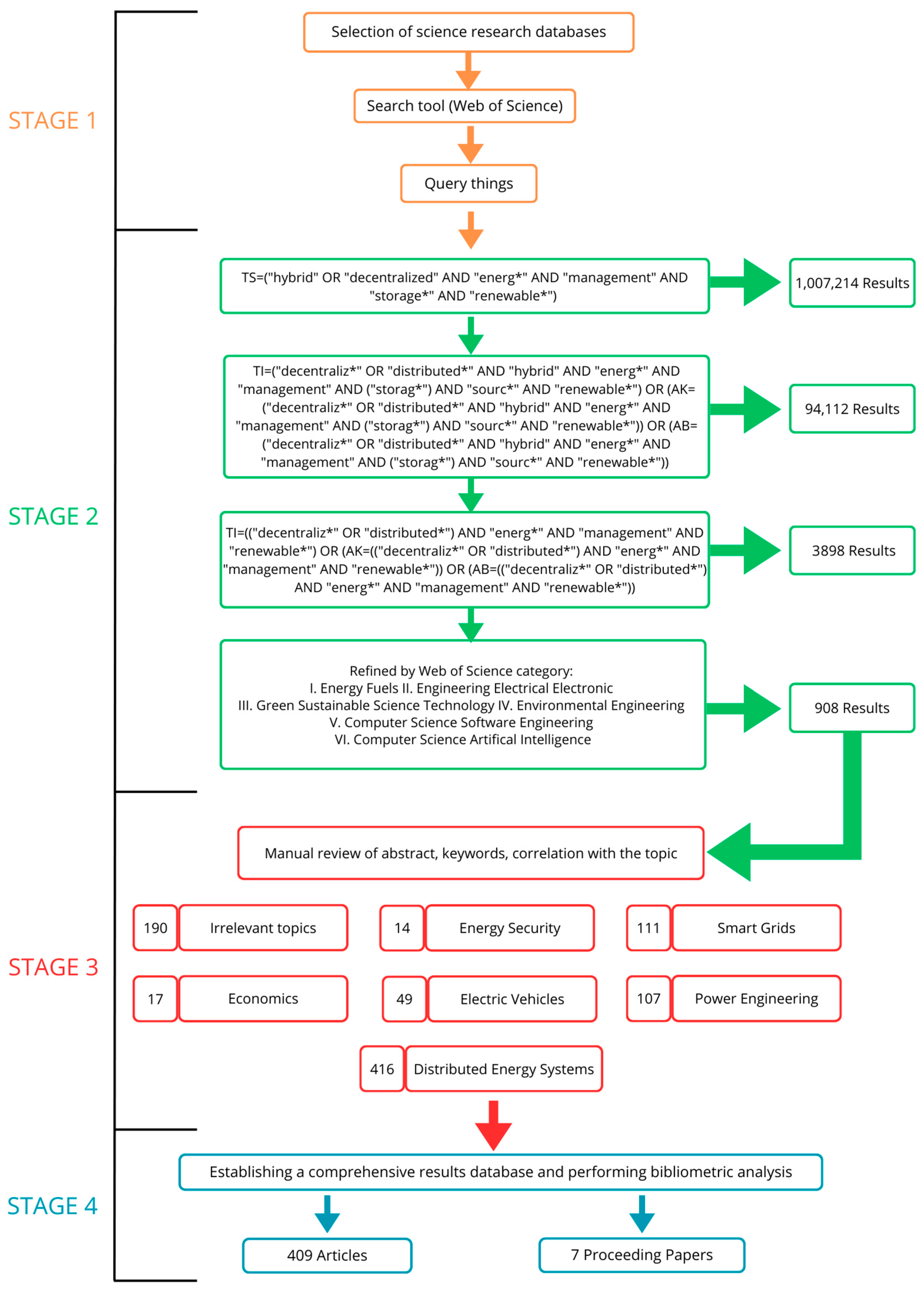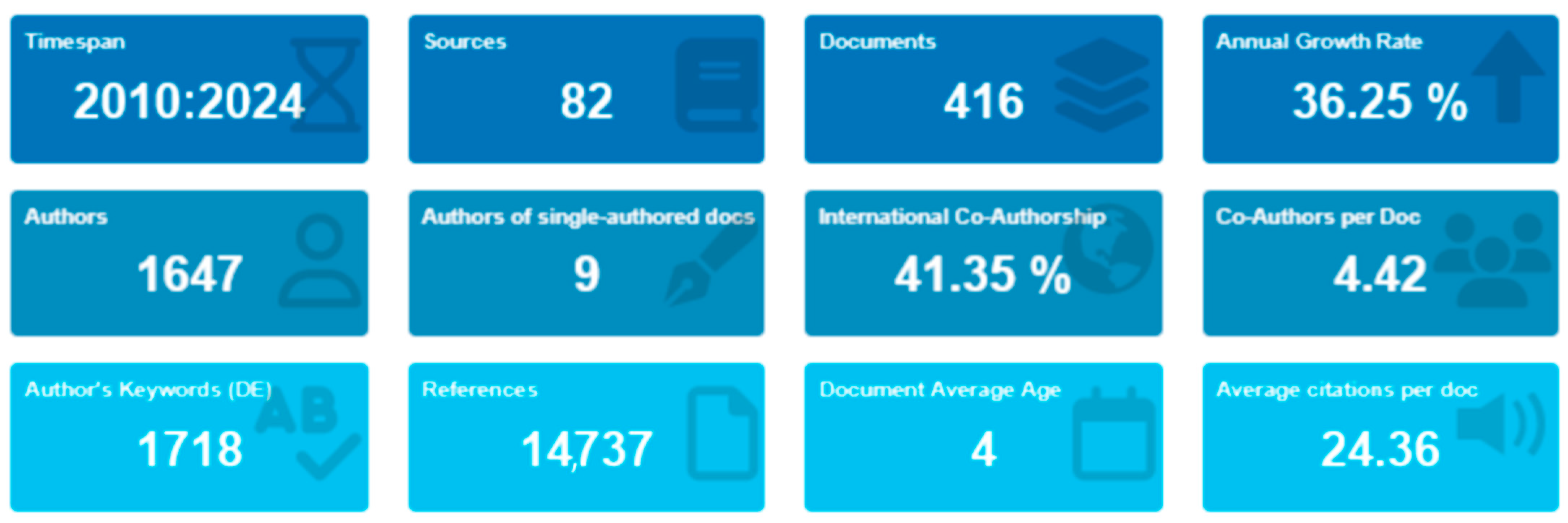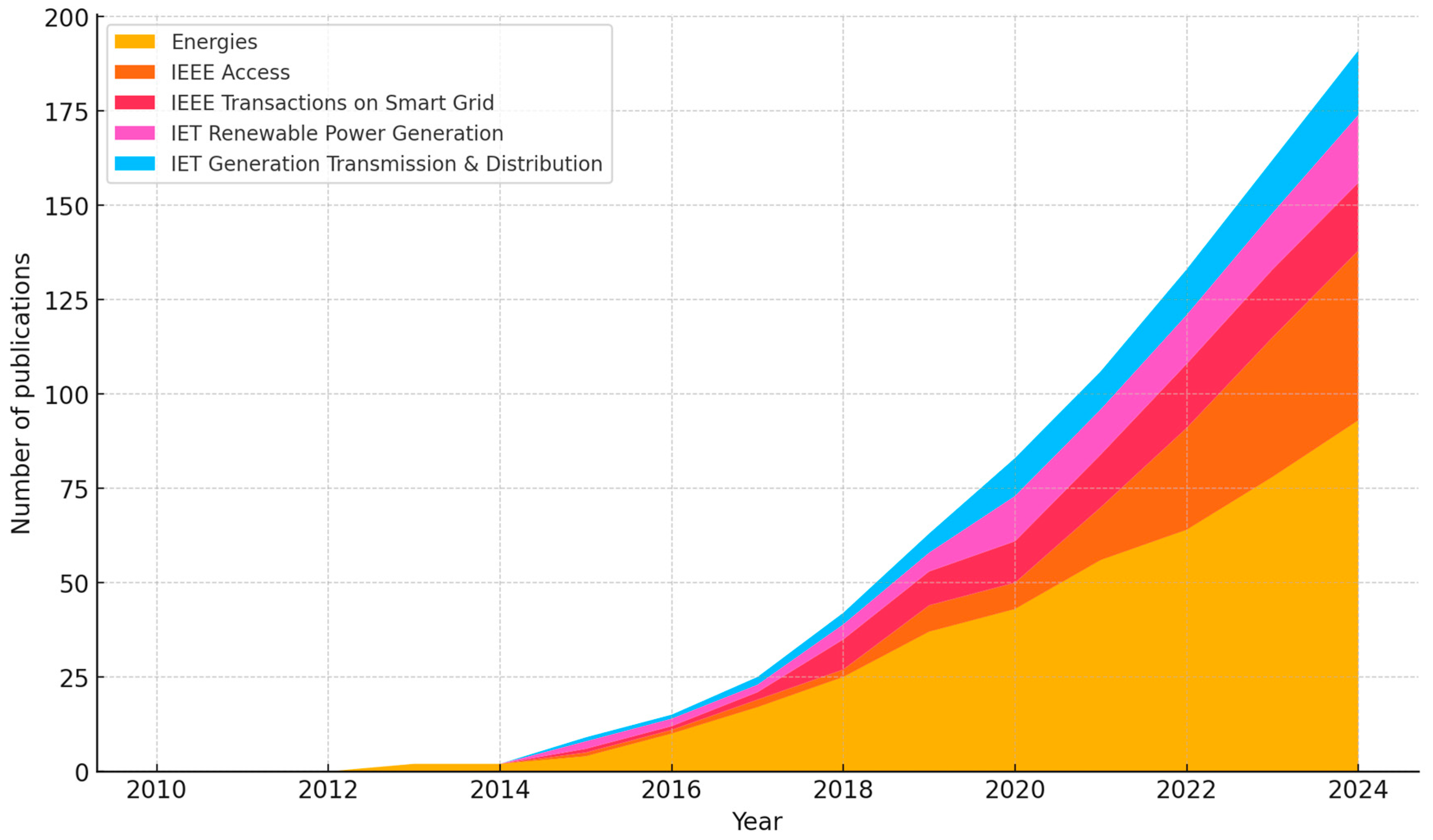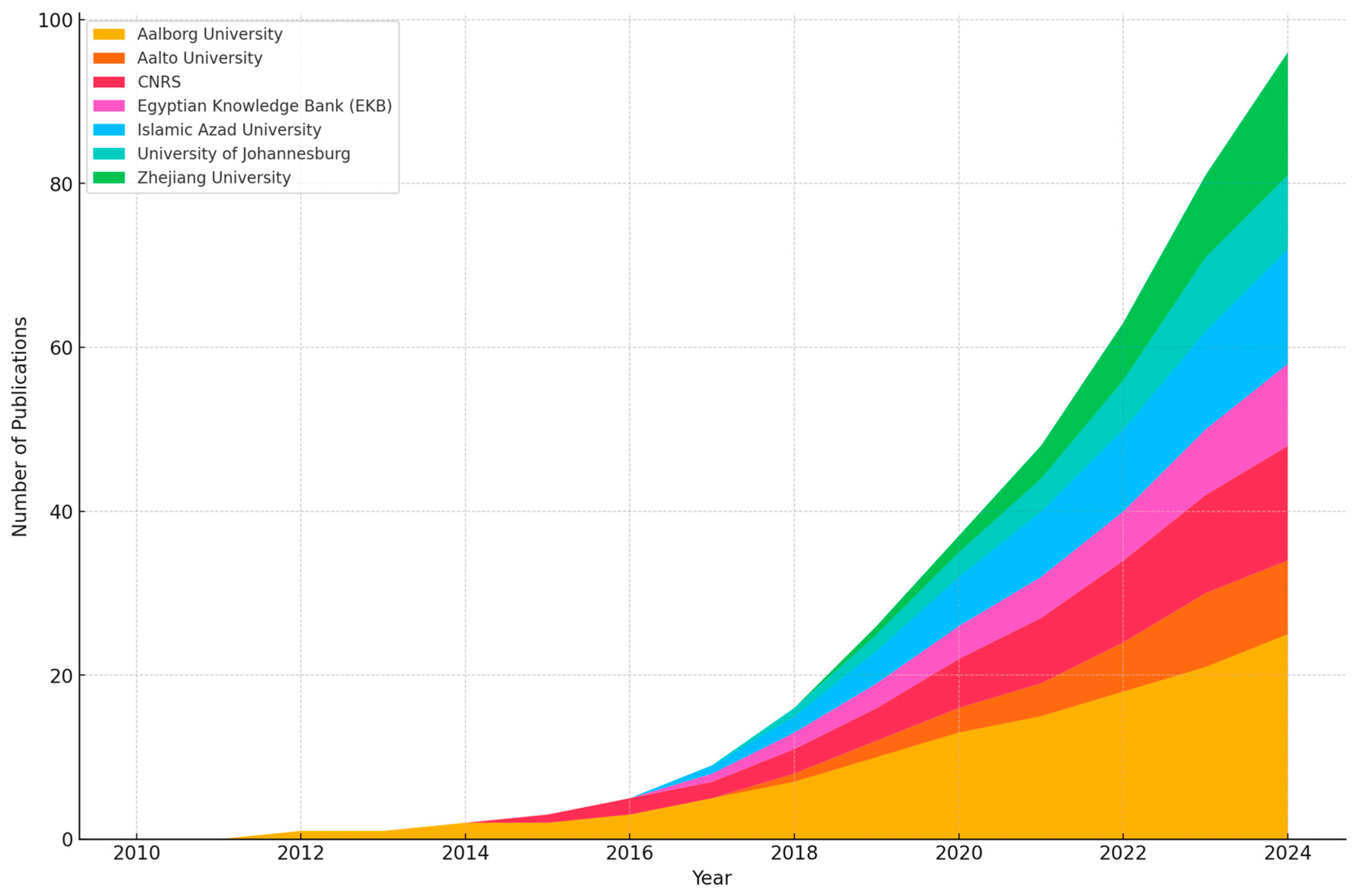Managing and Optimizing Hybrid Distributed Energy Systems: A Bibliometric Mapping of Current Knowledge and Strategies
Abstract
1. Introduction
2. Materials and Methods
3. Results
4. Conclusions
Author Contributions
Funding
Data Availability Statement
Conflicts of Interest
References
- U.S. Department of Energy. Available online: https://www.energy.gov/fossil (accessed on 17 February 2025).
- The European Green Deal. Available online: https://commission.europa.eu/strategy-and-policy/priorities-2019-2024/european-green-deal/delivering-european-green-deal_en (accessed on 17 February 2025).
- Energy Roadmap 2050; Publications Office of the European Union: Luxembourg, 2012; ISBN 978-92-79-21798-2. Available online: https://op.europa.eu/en/publication-detail/-/publication/e758bc9e-b2f9-43f7-8149-ea03becf5c61/language-en (accessed on 17 February 2025).
- Pérez Uc, D.A.; de León Aldaco, S.E.; Aguayo Alquicira, J. Trends in Hybrid Renewable Energy System (HRES) Applications: A Review. Energies 2024, 17, 2578. [Google Scholar] [CrossRef]
- Stec, A.; Słyś, D.; Ogarek, P.; Bednarz, K.; Bartkowska, I.; Gwoździej-Mazur, J.; Iwanek, M.; Kowalska, B. Assessment of Possibilities of Using Local Renewable Resources in Road Infrastructure Facilities—A Case Study from Poland. Energies 2024, 17, 6351. [Google Scholar] [CrossRef]
- Ahmadi, M.H.; Ghazvini, M.; Sadeghzadeh, M.; Nazari, M.A.; Kumar, R.; Naeimi, A.; Ming, T. Solar power technology for electricity generation: A critical review. Energy Sci. Eng. 2018, 6, 340–361. [Google Scholar] [CrossRef]
- Olabi, A.G.; Wilberforce, T.; Elsaid, K.; Salameh, T.; Sayed, E.T.; Husain, K.S.; Abdelkareem, M.A. Selection Guidelines for Wind Energy Technologies. Energies 2021, 14, 3244. [Google Scholar] [CrossRef]
- Alfonso-Solar, D.; Vargas-Salgado, C.; Sánchez-Díaz, C.; Hurtado-Pérez, E. Small-Scale Hybrid Photovoltaic-Biomass Systems Feasibility Analysis for Higher Education Buildings. Sustainability 2020, 12, 9300. [Google Scholar] [CrossRef]
- Aghahosseini, A.; Breyer, C. From hot rock to useful energy: A global estimate of enhanced geothermal systems potential. Appl. Energy 2020, 279, 115769. [Google Scholar] [CrossRef]
- Stec, A.; Pochwat, K. Assessment of the efficiency of shower wastewater heat exchangers using machine learning-based methods. J. Build. Eng. 2025, 103, 112062. [Google Scholar] [CrossRef]
- Starzec, M.; Kordana-Obuch, S.; Piotrowska, B. Evaluation of the Suitability of Using Artificial Neural Networks in Assessing the Effectiveness of Greywater Heat Exchangers. Sustainability 2024, 16, 2790. [Google Scholar] [CrossRef]
- Kordana-Obuch, S.; Starzec, M.; Wojtoń, M.; Słyś, D. Greywater as a Future Sustainable Energy and Water Source: Bibliometric Mapping of Current Knowledge and Strategies. Energies 2023, 16, 934. [Google Scholar] [CrossRef]
- Sayed, E.T.; Olabi, A.G.; Alami, A.H.; Radwan, A.; Mdallal, A.; Rezk, A.; Abdelkareem, M.A. Renewable Energy and Energy Storage Systems. Energies 2023, 16, 1415. [Google Scholar] [CrossRef]
- Zhang, G.; Zhou, H.; Ge, Y.; Magabled, S.M.; Abbas, M.; Pan, X.; Jose Ponnore, J.; Asilza, H.; Liu, J.; Yang, Y. Enhancing on-grid renewable energy systems: Optimal configuration and diverse design strategies. Renew. Energy 2024, 235, 121103. [Google Scholar] [CrossRef]
- Javed, H.; Muqeet, H.A.; Shehzad, M.; Jamil, M.; Khan, A.A.; Guerrero, J.M. Optimal Energy Management of a Campus Microgrid Considering Financial and Economic Analysis with Demand Response Strategies. Energies 2021, 14, 8501. [Google Scholar] [CrossRef]
- Elalfy, D.; Gouda, E.; Kotb, M.; Bureš, V.; Sedhom, B. Comprehensive review of energy storage systems technologies, objectives, challenges, and future trends. Energy Strategy Rev. 2024, 54, 101482. [Google Scholar] [CrossRef]
- Xu, J.; Zeng, J.; Huang, J. A management system for energy storage. Appl. Energy 2024, 368, 123434. [Google Scholar] [CrossRef]
- Choudhury, S. Review of energy storage system technologies integration to microgrid: Types, control strategies, issues, and future prospects. J. Energy Storage 2022, 48, 103966. [Google Scholar] [CrossRef]
- Twaha, S.; Ramli, M. A review of optimization approaches for hybrid distributed energy generation systems: Off-grid and grid-connected systems. Sustain. Cities Soc. 2018, 41, 320–331. [Google Scholar] [CrossRef]
- He, Y.; Zhou, Y.; Yuan, J.; Liu, Z.; Wang, Z.; Zhang, G. Transformation towards a carbon-neutral residential community with hydrogen economy and advanced energy management strategies. Energy Convers. Manag. 2021, 249, 114834. [Google Scholar] [CrossRef]
- Ogarek, P.; Wojtoń, M.; Słyś, D. Hydrogen as a Renewable Energy Carrier in a Hybrid Configuration of Distributed Energy Systems: Bibliometric Mapping of Current Knowledge and Strategies. Energies 2023, 16, 5495. [Google Scholar] [CrossRef]
- Wali, S.B.; Hannan, M.A.; Ker, P.; Rahman, S.; Le, K.; Begum, R.; Tiong, S.; Mahlia, T. Grid-connected lithium-ion battery energy storage system towards sustainable energy: A patent landscape analysis and technology updates. J. Energy Storage 2024, 77, 109986. [Google Scholar] [CrossRef]
- Sunny, M.; Ali, T.; Aghaloo, K.; Wang, K. Techno-economic feasibility of stand-alone hybrid renewable energy system with battery storage in educational buildings: A case study of Uttara University. Energy Build. 2024, 304, 113852. [Google Scholar] [CrossRef]
- Abdoulaye, M.; Waita, S.; Wekesa, C.; Mwabora, J. Optimal sizing of an off-grid and grid-connected hybrid photovoltaic-wind system with battery and fuel cell storage system: A techno-economic, environmental, and social assessment. Appl. Energy 2024, 365, 123201. [Google Scholar] [CrossRef]
- Rathod, A.A.; Subramanian, B. Scrutiny of Hybrid Renewable Energy Systems for Control, Power Management, Optimization and Sizing: Challenges and Future Possibilities. Sustainability 2022, 14, 16814. [Google Scholar] [CrossRef]
- Khalil, L.; Bhatti, K.L.; Awan, M.; Riaz, M.; Khalil, K.; Alwaz, N. Optimization and designing of hybrid power system using HOMER pro, Mater. Today Proc. 2021, 42, S110–S115. [Google Scholar] [CrossRef]
- Kavadias, K.A.; Triantafyllou, P. Hybrid renewable energy systems’ optimisation. A review and extended comparison of the most-used software tools. Energies 2021, 14, 8268. [Google Scholar] [CrossRef]
- Thirunavukkarasu, M.; Sawle, Y.; Lala, H. A comprehensive review on optimization of hybrid renewable energy systems using various optimization techniques. Renew. Sustain. Energy Rev. 2023, 176, 113192. [Google Scholar] [CrossRef]
- Sousa, J.; Lagarto, J.; Camus, C.; Viveiros, C.; Barata, F.; Silva, P.; Alegria, R.; Paraíba, O. Renewable energy communities optimal design supported by an optimization model for investment in PV/wind capacity and renewable electricity sharing. Energy 2023, 283, 128464. [Google Scholar] [CrossRef]
- Singh, S.; Singh, M.; Kaushik, S.C. A Review on Optimization Techniques for Sizing of Solar-Wind Hybrid renewable energy systems. Int. J. Green Energy 2016, 13, 1564–1578. [Google Scholar] [CrossRef]
- De Din, E.; Pau, M.; Ponci, F.; Monti, A. A Coordinated Voltage Control for Overvoltage Mitigation in LV Distribution Grids. Energies 2020, 13, 2007. [Google Scholar] [CrossRef]
- Hakimi, S.; Saadatmandi, M.; Shafie-khah, M.; Catalão, J. Smart household management systems with renewable generation to increase the operation profit of a microgrid. IET Smart Grid 2019, 4, 522–528. [Google Scholar] [CrossRef]
- Ammari, C.; Belatrache, D.; Touhami, B.; Makhloufi, S. Sizing, Optimization, Control and Energy Management of Hybrid Renewable Energy System—A Review. Energy Built Environ. 2021, 3, 399–411. [Google Scholar] [CrossRef]
- He, Y.; Guo, S.; Dong, P.; Zhang, Y.; Huang, J.; Zhou, J. A state-of-the-art review and bibliometric analysis on the sizing optimization of off-grid hybrid renewable energy systems. Renew. Sustain. Energy Rev. 2023, 183, 113476. [Google Scholar] [CrossRef]
- Memon, S.A.; Patel, R.N. An overview of optimization techniques used for sizing of hybrid renewable energy systems. Renew. Energy Focus 2021, 39, 1–26. [Google Scholar] [CrossRef]
- Homa, M.; Pałac, A.; Żołądek, M.; Figaj, R. Small-Scale Hybrid and Polygeneration Renewable Energy Systems: Energy Generation and Storage Technologies, Applications, and Analysis Methodology. Energies 2022, 15, 9152. [Google Scholar] [CrossRef]
- Agajie, T.F.; Ali, A.; Fopah-Lele, A.; Amoussou, I.; Khan, B.; Velasco, C.L.R.; Tanyi, E. A Comprehensive Review on Techno-Economic Analysis and Optimal Sizing of Hybrid Renewable Energy Sources with Energy Storage Systems. Energies 2023, 16, 642. [Google Scholar] [CrossRef]
- Siano, P.; De Marco, G.; Rolan, A.; Loia, V. A Survey and Evaluation of the Potentials of Distributed Ledger Technology for Peer-to-Peer Transactive Energy Exchanges in Local Energy Markets. IEEE Syst. J. 2019, 13, 3454–3466. [Google Scholar] [CrossRef]
- Zou, H.; Mao, S.; Wang, Y.; Zhang, F.; Chen, X.; Cheng, L. A Survey of Energy Management in Interconnected Multi-Microgrids. IEEE Access 2019, 7, 72158–72169. [Google Scholar] [CrossRef]
- Zafar, U.; Bayhan, S.; Sanfilippo, A. Home Energy Management System Concepts, Configurations, and Technologies for the Smart Grid. IEEE Access 2020, 8, 119271–119286. [Google Scholar] [CrossRef]
- Mbungu, N.; Naidoo, R.; Bansal, R.; Vahidinasab, V. Overview of the Optimal Smart Energy Coordination for Microgrid Applications. IEEE Access 2019, 7, 163063–163084. [Google Scholar] [CrossRef]
- Alonso-Travesset, A.; Martin, H.; Coronas, S.; de la Hoz, J. Optimization Models under Uncertainty in Distributed Generation Systems: A Review. Energies 2022, 15, 1932. [Google Scholar] [CrossRef]
- Liu, X.; Zhao, T.Y.; Deng, H.; Wang, P.; Liu, J.Z.; Blaabjerg, F. Microgrid Energy Management with Energy Storage Systems: A Review. CSEE J. Power Energy Syst. 2023, 9, 483–504. [Google Scholar] [CrossRef]
- Bilal, M.; Algethami, A.A.; Imdadullah Hameed, S. Review of Computational Intelligence Approaches for Microgrid Energy Management. IEEE Access 2024, 12, 123294–123321. [Google Scholar] [CrossRef]
- Zhou, Y. Energy-Sharing Economy with Renewable Integration and Management in Communities—A State-of-the-Art Review. Adv. Energy Sustain. Res. 2024, 5, 2400214. [Google Scholar] [CrossRef]
- Agha Kassab, F.; Rodriguez, R.; Celik, B.; Locment, F.; Sechilariu, M. A Comprehensive Review of Sizing and Energy Management Strategies for Optimal Planning of Microgrids with PV and Other Renewable Integration. Appl. Sci. 2024, 14, 10479. [Google Scholar] [CrossRef]
- Passas, I. Bibliometric Analysis: The Main Steps. Encyclopedia 2024, 4, 1014–1025. [Google Scholar] [CrossRef]
- Donthu, N.; Kumar, S.; Mukherjee, D.; Pandey, N.; Lim, W. How to conduct a bibliometric analysis: An overview and guidelines. J. Bus. Res. 2021, 133, 285–296. [Google Scholar] [CrossRef]
- Birkle, C.; Pendlebury, D.; Schnell, J.; Adams, J. Web of Science as a data source for research on scientific and scholarly activity. Quant. Sci. Stud. 2020, 1, 363–376. [Google Scholar] [CrossRef]
- Aria, M.; Cuccurullo, C. bibliometrix: An R-tool for comprehensive science mapping analysis. J. Informetr. 2017, 11, 959–975. [Google Scholar] [CrossRef]
- van Eck, N.J.; Waltman, L. Software survey: VOSviewer, a computer program for bibliometric mapping. Scientometrics 2010, 84, 523–538. [Google Scholar] [CrossRef]
- Waltman, L.; van Eck, N.J.; Noyons Ed, C.M. A unfified approach to mapping and clustering of bibliometric networks. J. Informetr. 2010, 4, 629–635. [Google Scholar] [CrossRef]
- Liu, W.; Ni, R.; Hu, G. Web of science core collection’s coverage expansion: The forgotten arts & humanities citation index? Scientometrics 2024, 129, 933–955. [Google Scholar] [CrossRef]
- Zhang, Y.; Gatsis, N.; Giannakis, G.B. Robust Energy Management for Microgrids With High-Penetration Renewables. IEEE Trans. Sustain. Energy 2013, 4, 944–953. [Google Scholar] [CrossRef]
- Morstyn, T.; McCulloch, M.D. Multiclass Energy Management for Peer-to-Peer Energy Trading Driven by Prosumer Preferences. IEEE Trans. Power Syst. 2019, 34, 4005–4014. [Google Scholar] [CrossRef]
- Arcos-Aviles, D.; Pascual, J.; Marroyo, L.; Sanchis, P.; Guinjoan, F. Fuzzy Logic-Based Energy Management System Design for Residential Grid-Connected Microgrids. IEEE Trans. Smart Grid 2018, 9, 530–543. [Google Scholar] [CrossRef]
- Wu, Z.; Tazvinga, H.; Xia, X. Demand side management of photovoltaic-battery hybrid system. Appl. Energy 2015, 148, 294–304. [Google Scholar] [CrossRef]
- Li, X.; Wang, S. A review on energy management, operation control and application methods for grid battery energy storage systems. CSEE J. Power Energy Syst. 2019, 7, 1026–1040. [Google Scholar] [CrossRef]
- Wu, D.; Tang, F.; Dragicevic, T.; Vasquez, J.C.; Guerrero, J.M. Autonomous Active Power Control for Islanded AC Microgrids With Photovoltaic Generation and Energy Storage System. IEEE Trans. Energy Convers. 2014, 29, 882–892. [Google Scholar] [CrossRef]
- Talari, S.; Yazdaninejad, M.; Haghifam, M. Stochastic-based scheduling of the microgrid operation including wind turbines, photovoltaic cells, energy storages and responsive loads. IET Gener. Transm. Distrib. 2015, 9, 1498–1509. [Google Scholar] [CrossRef]
- Krishan, O.; Suhag, S. An updated review of energy storage systems: Classification and applications in distributed generation power systems incorporating renewable energy resources. Int. J. Energy Res. 2019, 43, 6171–6210. [Google Scholar] [CrossRef]
- Hosseinzadeh, M.; Salmasi, F.R. Power management of an isolated hybrid AC/DC micro-grid with fuzzy control of battery banks. IET Renew. Power Gener. 2015, 9, 484–493. [Google Scholar] [CrossRef]
- Nikmehr, N.; Najafi-Ravadanegh, S. Optimal operation of distributed generations in micro-grids under uncertainties in load and renewable power generation using heuristic algorithm. IET Renew. Power Gener. 2015, 9, 982–990. [Google Scholar] [CrossRef]
- Tang, L. Halt the ongoing decoupling and reboot US-China scientific collaboration. J. Informetr. 2024, 18, 101521. [Google Scholar] [CrossRef]
- Thelwall, M. The discretised lognormal and hooked power law distributions for complete citation data: Best options for modelling and regression. J. Informetr. 2016, 10, 336–346. [Google Scholar] [CrossRef]
- Liu, W.; Hu, G.; Tang, L. Missing author address information in Web of Science—An explorative study. J. Informetr. 2018, 12, 985–997. [Google Scholar] [CrossRef]








| Title | Year | Citation | References |
|---|---|---|---|
| A Survey and Evaluation of the Potentials of Distributed Ledger Technology for Peer-to-Peer Transactive Energy Exchanges in Local Energy Markets [38] | 2019 | 256 | 84 |
| A Survey of Energy Management in Interconnected Multi-Microgrids [39] | 2019 | 140 | 92 |
| Home Energy Management System Concepts, Configurations, and Technologies for the Smart Grid [40] | 2020 | 93 | 118 |
| Overview of the Optimal Smart Energy Coordination for Microgrid Applications [41] | 2019 | 61 | 274 |
| Optimization Models under Uncertainty in Distributed Generation Systems: A Review [42] | 2022 | 12 | 224 |
| Microgrid Energy Management with Energy Storage Systems: A Review [43] | 2023 | 34 | 163 |
| Review of Computational Intelligence Approaches for Microgrid Energy Management [44] | 2024 | 6 | 226 |
| Energy-Sharing Economy with Renewable Integration and Management in Communities—a State-of-the-Art Review [45] | 2024 | 1 | 124 |
| A Comprehensive Review of Sizing and Energy Management Strategies for Optimal Planning of Microgrids with PV and Other Renewable Integration [46] | 2024 | 2 | 146 |
| Authors | Title | Journal | Year of Publication | Citations | Impact Factor | JIF |
|---|---|---|---|---|---|---|
| Zhang et al. [54] | Robust Energy Management for Microgrids with High-Penetration Renewables | IEEE Transactions on Sustainable Energy | 2013 | 592 | 8.6 | Q1 |
| Morstyn et al. [55] | Multiclass Energy Management for Peer-to-Peer Energy Trading Driven by Prosumer Preferences | IEEE Transactions on Power Systems | 2019 | 358 | 6.5 | Q1 |
| Arcos-Aviles et al. [56] | Fuzzy Logic-Based Energy Management System Design for Residential Grid-Connected Microgrids | IEEE Transactions on Smart Grid | 2018 | 216 | 8.6 | Q1 |
| Wu et al. [57] | Demand side management of photovoltaic-battery hybrid system | Applied Energy | 2015 | 212 | 10.1 | Q1 |
| Li et al. [58] | Energy Management and Operational Control Methods for Grid Battery Energy Storage Systems | CSEE Journal of Power and Energy Systems | 2021 | 208 | 6.9 | Q1 |
| Wu et al. [59] | Autonomous Active Power Control for Islanded AC Microgrids With Photovoltaic Generation and Energy Storage System | IEEE Transactions on Energy Conversion | 2014 | 191 | 5.0 | Q1 |
| Talari et al. [60] | Stochastic-based scheduling of the microgrid operation including wind turbines, photovoltaic cells, energy storages and responsive loads | IET Generation Transmission & Distribution | 2015 | 182 | 2.0 | Q3 |
| Krishan et al. [61] | An updated review of energy storage systems: Classification and applications in distributed generation power systems incorporating renewable energy resources | International Journal of Energy Research | 2018 | 173 | 4.3 | Q1 |
| Hosseinzadeh et al. [62] | Power management of an isolated hybrid AC/DC micro-grid with fuzzy control of battery banks | IET Renewable Power Generation | 2015 | 170 | 2.6 | Q2 |
| Nikmehr et al. [63] | Optimal operation of distributed generations in micro-grids under uncertainties in load and renewable power generation using heuristic algorithm | IET Renewable Power Generation | 2015 | 152 | 2.6 | Q2 |
| Keyword | Cluster | Occurrences | Average Citations | Links |
|---|---|---|---|---|
| management | 1 | 56 | 27.82 | 52 |
| operation | 1 | 53 | 7.75 | 51 |
| demand response | 1 | 47 | 21.31 | 54 |
| generation | 1 | 45 | 19.07 | 54 |
| distributed power generation | 1 | 37 | 28.27 | 48 |
| model | 1 | 37 | 16.33 | 47 |
| uncertainty | 1 | 31 | 30.36 | 45 |
| distributed energy resources | 1 | 28 | 14.43 | 47 |
| strategy | 1 | 28 | 10.00 | 45 |
| energy | 1 | 27 | 39.59 | 42 |
| distributed networks | 1 | 22 | 7.58 | 44 |
| electric vehicles | 1 | 22 | 9.72 | 41 |
| wind | 1 | 20 | 55.50 | 43 |
| energy management systems | 1 | 18 | 6.12 | 35 |
| blockchain | 1 | 16 | 34.50 | 29 |
| dispatch | 1 | 15 | 84.00 | 37 |
| optimisation | 1 | 15 | 12.94 | 35 |
| reliability | 1 | 13 | 7.66 | 35 |
| demand | 1 | 12 | 54.16 | 29 |
| framework | 1 | 12 | 7.60 | 29 |
| virtual power plant | 1 | 12 | 7.72 | 23 |
| coordination | 1 | 11 | 16.00 | 32 |
| optimization | 2 | 122 | 28.88 | 56 |
| system | 2 | 77 | 43.26 | 54 |
| microgrid | 2 | 57 | 31.08 | 51 |
| distributed generation | 2 | 40 | 30.03 | 51 |
| smart grid | 2 | 36 | 34.14 | 47 |
| design | 2 | 34 | 19.50 | 52 |
| energy management system | 2 | 34 | 20.83 | 49 |
| algorithm | 2 | 27 | 47.71 | 43 |
| demand side management | 2 | 22 | 43.85 | 45 |
| demand-side management | 2 | 21 | 20.42 | 37 |
| battery | 2 | 17 | 34.60 | 32 |
| energy storage system | 2 | 15 | 34.57 | 39 |
| renewable energy resources | 2 | 10 | 36.33 | 33 |
| solar energy | 2 | 10 | 47.60 | 31 |
| technologies | 2 | 10 | 6.50 | 31 |
| energy management | 3 | 88 | 34.98 | 57 |
| renewable energy | 3 | 63 | 14.17 | 53 |
| storage | 3 | 57 | 38.67 | 56 |
| microgrids | 3 | 52 | 35.82 | 50 |
| systems | 3 | 50 | 18.75 | 50 |
| ac | 3 | 12 | 3.00 | 41 |
| distributed optimization | 3 | 11 | 17.18 | 22 |
| electricity | 3 | 11 | 19.00 | 32 |
| peer-to-peer | 3 | 11 | 63.88 | 22 |
| power management | 3 | 10 | 5.50 | 26 |
| pv | 3 | 10 | 13.00 | 37 |
| renewable energy sources | 4 | 66 | 20.21 | 56 |
| energy storage | 4 | 34 | 30.58 | 52 |
| integration | 4 | 24 | 4.50 | 42 |
| power | 4 | 24 | 35.23 | 47 |
| smart grids | 4 | 22 | 16.52 | 42 |
| batteries | 4 | 15 | 17.68 | 36 |
| costs | 4 | 17 | 17.05 | 38 |
| solar | 4 | 11 | 25.20 | 34 |
| flexibility | 4 | 10 | 10.83 | 29 |
| simulation | 4 | 10 | 12.00 | 27 |
| From | To | Total Number of Publications |
|---|---|---|
| China | USA | 16 |
| China | Denmark | 11 |
| Iran | Finland | 8 |
| Pakistan | Saudi Arabia | 8 |
| China | Pakistan | 6 |
| Iran | Denmark | 6 |
| China | United Kingdom | 5 |
| Iran | Italy | 5 |
| Italy | Denmark | 5 |
| Spain | Colombia | 5 |
| United Kingdom | Saudi Arabia | 5 |
| China | Saudi Arabia | 5 |
Disclaimer/Publisher’s Note: The statements, opinions and data contained in all publications are solely those of the individual author(s) and contributor(s) and not of MDPI and/or the editor(s). MDPI and/or the editor(s) disclaim responsibility for any injury to people or property resulting from any ideas, methods, instructions or products referred to in the content. |
© 2025 by the authors. Licensee MDPI, Basel, Switzerland. This article is an open access article distributed under the terms and conditions of the Creative Commons Attribution (CC BY) license (https://creativecommons.org/licenses/by/4.0/).
Share and Cite
Słyś, D.; Stec, A.; Bednarz, K.; Ogarek, P.; Zeleňáková, M. Managing and Optimizing Hybrid Distributed Energy Systems: A Bibliometric Mapping of Current Knowledge and Strategies. Energies 2025, 18, 2497. https://doi.org/10.3390/en18102497
Słyś D, Stec A, Bednarz K, Ogarek P, Zeleňáková M. Managing and Optimizing Hybrid Distributed Energy Systems: A Bibliometric Mapping of Current Knowledge and Strategies. Energies. 2025; 18(10):2497. https://doi.org/10.3390/en18102497
Chicago/Turabian StyleSłyś, Daniel, Agnieszka Stec, Kacper Bednarz, Przemysław Ogarek, and Martina Zeleňáková. 2025. "Managing and Optimizing Hybrid Distributed Energy Systems: A Bibliometric Mapping of Current Knowledge and Strategies" Energies 18, no. 10: 2497. https://doi.org/10.3390/en18102497
APA StyleSłyś, D., Stec, A., Bednarz, K., Ogarek, P., & Zeleňáková, M. (2025). Managing and Optimizing Hybrid Distributed Energy Systems: A Bibliometric Mapping of Current Knowledge and Strategies. Energies, 18(10), 2497. https://doi.org/10.3390/en18102497








